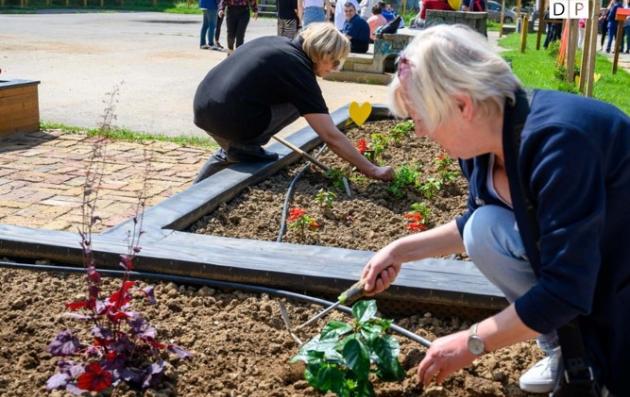Date of label : 29/10/2024
-
Centar Sarajevo , Bosnia-Herzegovina
-
Size of city : 300.000 inhabitants

People cultivating a vegetable garden
Summary
The first urban garden with sensory elements created in the City of Sarajevo (BA) represented a pioneering initiative to support children and young people with developmental disabilities. It offers a holistic space for recreation, fostering intergenerational connections and promoting mental and physical well-being. Through innovative sensory elements, it caters to diverse needs, enhancing community cohesion. This sustainable endeavour revitalises urban spaces, fostering environmental stewardship and resilience. Its scalable model exemplifies inclusive urban planning that champions community health and ecological sustainability.
The solutions offered by the Good Practice
The pioneering Urban Garden and Sensory Park in Sarajevo reflects the city’s 2021-2027 vision for inclusive urban development. It provides tailored support to children with developmental disabilities, at the School for Secondary Vocational Education and Work Training in the Municipality of Novo Sarajevo. The park features plantings and structures with sensory elements.
By repurposing underutilised urban land the initiative addresses the community's need for inclusive recreational spaces, while fostering intergenerational engagement, social cohesion, environmental stewardship, sustainability and resilience. Notable outcomes include enhanced community well-being, improved biodiversity, and reduced water consumption.
Building on the sustainable and integrated urban approach
The holistic approach taken when creating the urban garden and sensory park addresses environmental, economic, and social dimensions, to ensure a sustainable urban development for current and future generations.
Environmental: Sustainability was boosted by turning an underutilised urban space into green areas that enhance biodiversity, and by incorporating native plant species and low-maintenance landscaping to reduce water use and support local ecosystems, thereby mitigating environmental degradation and contributing to climate resilience.
Economic: Economic activity in the area was stimulated by visitors attracted to the garden.
Social: The inclusive urban garden meets diverse needs, providing welcoming accessible spaces for children with disabilities and senior citizens, while promoting social cohesion, intergenerational connections with nature, and general well-being.
Based on participatory approach
Sarajevo's inaugural Urban Garden and Sensory Park showcased a participatory approach from start to finish. Initated by the City of Sarajevo, with the Sarajevo Regional Development Agency (SERDA), supported by EU Horizon 2020 funds, the project’s partnership with the Municipality of Novo Sarajevo and the local vocational school ensured it met community needs, particularly for individuals with developmental disabilities.
The United Nations Development Programme’s "Re-imagine my street" initiative enhanced the participatory process, through brainstorming sessions with residents and local organisations to envision the urban garden and sensory park. Citizens' ideas were incorporated into the design, with the collaborative approach fostered a sense of ownership and collective responsibility that ensures the urban garden and sensory park aligns with the community’s preferences.
What difference has it made?
The urban area initially lacked inclusive recreational spaces, particularly for people with disabilities, and before the project the space contributed to urban decay and social isolation. The Urban Garden and Sensory Park turned the space into a vibrant hub for people of all ages and abilities, fostering social interactions and inclusivity. The sensory elements stimulate engagement and provide a unique experience for visitors.
Moreover, the project's focus on environmental sustainability enriched the urban landscape, with native plants and green infrastructure enhancing biodiversity and ecological resilience.
The park’s amenties and inclusive design benefits a wide range of community members, including children, youth, seniors, and individuals with disabilities. It has become a symbol of community pride and has strengthened social bonds.
This holistic transformation has improved people’s quality-of-life, by addressing social, environmental, and recreational needs and has set a precedent for inclusive, sustainable urban development.
Why this Good Practice should be transferred to other cities
This good practice, showcasing an inclusive and sustainable approach to urban development, is highly relevant for other European cities. By creating accessible green spaces, especially for children with disabilities, it addresses a universal need for inclusive recreation. Moreover, repurposing underused urban areas promotes resilience and environmental stewardship.
The Urban Garden and Sensory Park practice contributes to key policy frameworks:
- Sustainable Development Goals (SDGs): SDG 11 (Sustainable cities and communities) and other SDGs by enhancing urban inclusivity and resilience.
- The Urban Agenda for the EU and the Territorial Agenda 2030, by fostering social cohesion and sustainable development in urban areas.
Sarajevo's commitment to sustainable urban planning provides a good model for integrating green infrastructure for other cities wanting to replicate the approach. Collaboration with national agencies supports scalability, while flexible design options allow cities to tailor the project to their local needs.
For successful transfer to other cities, robust knowledge-sharing is essential. This includes project documentation, capacity-building support, and partnerships at local, regional, and international levels to facilitate the exchange of expertise and resources.
The practice has been shared with other cities through international conferences, webinars, and collaborative networks, promoting its replication and adaptation in different urban contexts.
